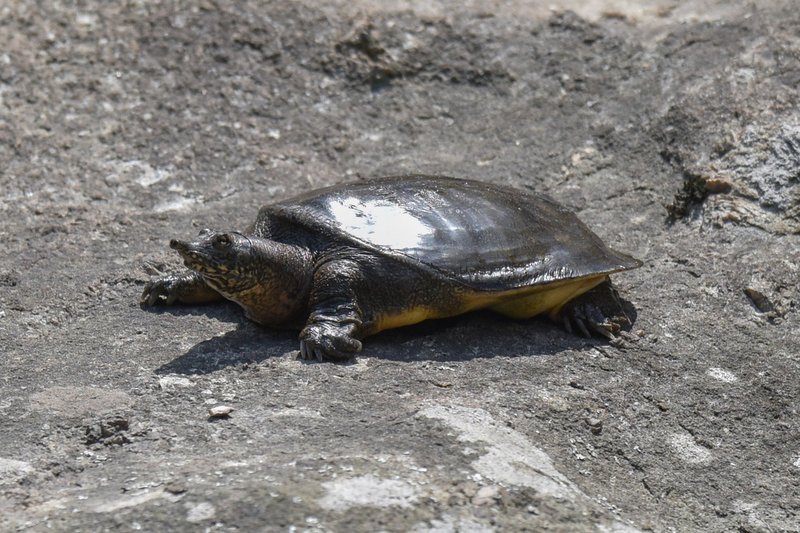
The Chinese Softshell Turtle is a species that often captures the imagination of animal lovers and curious minds alike. With its distinct flat shell and long neck, this turtle looks unlike many of its cousins in the reptile family. Think of it as the “cool kid” of the turtle world—always drawing attention with its unique appearance and lifestyle. Whether you’re interested in wildlife, considering one as a pet, or just curious about nature, there’s plenty to uncover about this intriguing creature.
These turtles are native to Asia, with a significant presence in the rivers and lakes of China. Their adaptability to different environments highlights their evolutionary success. But don’t let their tough looks fool you; the Chinese Softshell Turtle has its vulnerabilities, making it an important species for conservation efforts. In this article, we’ll explore their characteristics, habitat, and what makes them so special.
Physical Characteristics
What makes the Chinese Softshell Turtle stand out? For starters, its shell is unlike that of a typical turtle. The shell is smooth and leathery rather than hard and bony. This feature allows for greater flexibility and speed in the water, making them excellent swimmers. Adult turtles can reach lengths of up to 2 feet, although most are smaller. They have long, retractable necks that they can extend to catch prey, giving them a distinctive look that’s hard to forget.
The coloration of the Chinese Softshell Turtle varies, often featuring a pattern of olive green or brown with spots that help it blend into its surroundings. This camouflage is useful for both hunting and evading predators. Additionally, their webbed feet allow them to navigate through water with ease, almost like a natural design for swimming. With all these adaptations, it’s no wonder they thrive in their natural habitat.
Habitat and Range
Chinese Softshell Turtles prefer freshwater habitats, thriving in rivers, lakes, and ponds. They need shallow waters where they can bask in the sun on warm days, as these turtles are ectothermic, meaning they rely on external temperatures to regulate their body heat. These basking spots can often be found on logs or rocks, where they soak in the sun’s rays, recharging their energy.
These turtles are widely distributed across eastern and southeastern Asia, with China being their primary home. However, they have also been introduced to other areas, sometimes leading to ecological concerns. It’s fascinating how their adaptability has allowed them to spread to various water systems, which poses both opportunities and challenges for the environments they enter.
Diet and Feeding Habits
The diet of the Chinese Softshell Turtle is quite varied, reflecting its opportunistic feeding habits. In the wild, they primarily eat aquatic plants, fish, and small invertebrates. They are known to ambush their prey, relying on their speed and stealth. When a fish swims too close, these turtles are quick to extend their necks and snap it up! It’s a bit like watching a slow-motion chase in nature.
For those considering keeping a Chinese Softshell Turtle as a pet, it’s essential to replicate this balanced diet. Commercial turtle food can be supplemented with fresh fish, insects, and leafy greens. It’s important to ensure they receive a well-rounded diet to stay healthy. Just like any other pet, these turtles thrive best when their dietary needs are met.
Behavior and Social Structure
When it comes to behavior, Chinese Softshell Turtles can be quite solitary. They usually prefer to do their own thing, spending time lounging in the sun or swimming alone. However, they can sometimes be seen basking in groups during the day, which might seem social but is more about seeking the sun’s warmth than companionship.
Interestingly, during the breeding season, male turtles become more active and can often be seen courting females. This involves some fascinating displays, including head bobs and gentle nips, which can appear quite playful. Once mating occurs, the female will lay eggs in sandy banks, where the sun helps incubate them. This reproductive behavior is a critical aspect of their life cycle and essential for the survival of the species.
Conservation Status
The conservation status of the Chinese Softshell Turtle is concerning. They face threats from habitat loss, pollution, and over-exploitation for the pet trade and traditional medicine. As their natural habitats are destroyed and their populations decline, many conservationists are stepping in to help protect them. Various organizations are working to raise awareness about their plight and implement measures to ensure their survival.
Efforts include habitat restoration, breeding programs, and establishing protected areas. It’s crucial for us to get involved in these initiatives, whether through education or by supporting conservation efforts. After all, preserving the Chinese Softshell Turtle means preserving a unique part of our planet’s biodiversity.
Interesting Facts
| Scientific Name: | Rafetus swinhoei |
| Size: | Up to 2 feet long |
| Lifespan: | 30-40 years in the wild |
| Diet: | Omnivore (fish, plants, and insects) |
| Habitat: | Freshwater rivers, lakes, and ponds |
| Conservation Status: | Endangered |
Keeping a Chinese Softshell Turtle as a Pet
If you’re thinking of bringing a Chinese Softshell Turtle into your home, there are several important considerations to bear in mind. First, they require a spacious aquarium or pond setup, as they need plenty of room to swim and bask. A tank that holds at least 100 gallons is often recommended for adults, along with a strong filtration system to keep the water clean.
These turtles also need a basking area, such as a rock or a platform, where they can soak up UV light. This is crucial for their health, as it helps them metabolize calcium and maintain strong shells. It’s essential to mimic their natural environment as closely as possible to keep them happy and healthy.
Health Care and Maintenance
Like all pets, Chinese Softshell Turtles require regular health care. A veterinarian who specializes in reptiles is your best bet for routine check-ups. Look for signs of illness, such as lethargy, lack of appetite, or unusual swimming behavior. Maintaining a clean habitat is key to preventing health issues, as poor water quality can lead to respiratory infections and shell rot.
Feeding them a balanced diet, providing proper lighting, and ensuring clean water will go a long way in keeping your pet healthy. Additionally, regularly checking their shell for any signs of damage or disease is important. These simple steps can help you enjoy many years with your Chinese Softshell Turtle.
As we’ve explored, the Chinese Softshell Turtle is not just another reptile; it’s a vital part of our ecosystem with a unique lifestyle that deserves our respect and protection. With their fascinating adaptations and behaviors, they continue to intrigue both scientists and pet owners alike. By learning more about them and supporting conservation efforts, we can ensure that these remarkable creatures remain a part of our world for generations to come.
FAQ
What is the habitat of the Chinese Softshell Turtle like?
The habitat of the Chinese Softshell Turtle typically consists of freshwater bodies like rivers, lakes, and ponds. They thrive in areas with plenty of aquatic vegetation where they can find food and bask. These turtles prefer shallow waters that allow them to sunbathe effectively, which is essential for their well-being.
How long do Chinese Softshell Turtles live?
Chinese Softshell Turtles can have a remarkable lifespan, with many living up to 30-40 years in the wild. This longevity is influenced by various factors, including their habitat, diet, and any threats they may face. Proper care in captivity can help replicate these conditions and extend their life even further.
Are Chinese Softshell Turtles solitary or social animals?
Generally, Chinese Softshell Turtles are solitary creatures. They often prefer to spend their time alone but can sometimes be seen basking in groups. Their social interactions mainly occur during the breeding season, where males may display courting behaviors to attract females.
Can Chinese Softshell Turtles be kept as pets?
Yes, the Chinese Softshell Turtle can be kept as a pet, but they require special care. They need a sufficiently large tank, proper filtration, and a basking area to mimic their natural habitat. Prospective owners should be well-prepared for the commitment this entails, including long-term care and maintenance.
What do Chinese Softshell Turtles eat?
These turtles are omnivores, enjoying a diet that includes fish, plants, and small invertebrates. In captivity, their diet can be supplemented with commercial turtle food, fresh fish, and leafy greens. Providing a balanced diet is crucial for their health.
What are the main threats to the Chinese Softshell Turtle?
The Chinese Softshell Turtle faces multiple threats, including habitat loss, pollution, and overharvesting for the pet trade and traditional medicine. Conservation efforts are vital to protect their populations and habitats from further decline.
How do I know if my Chinese Softshell Turtle is healthy?
Look for signs of health such as clear eyes, active behavior, and a good appetite. Any lethargy, lack of interest in food, or abnormal swimming can indicate health issues. Regular vet check-ups are essential for monitoring their well-being and catching any problems early.
What kind of environment do they need in an aquarium?
A proper aquarium for a Chinese Softshell Turtle should be spacious—at least 100 gallons for adults— equipped with a strong filtration system to maintain water quality. They also need a basking area with UV lighting to ensure they receive adequate warmth and light.
What are some unique behaviors of the Chinese Softshell Turtle?
Chinese Softshell Turtles exhibit several interesting behaviors, like basking in the sun and ambushing prey. During mating season, males may perform head bobs and gentle nips to court females. Observing these behaviors can provide insights into their natural instincts and social interactions.
How can I contribute to the conservation of Chinese Softshell Turtles?
You can help conserve Chinese Softshell Turtles by supporting wildlife conservation organizations, spreading awareness about their plight, and avoiding products that contribute to habitat destruction. Even educating your friends and family about these turtles can make a difference in protecting them.
Are there any laws protecting Chinese Softshell Turtles?
In many regions, there are laws protecting the Chinese Softshell Turtle, as they are considered endangered. It’s essential to be aware of local regulations regarding their trading and keeping. Always ensure that any turtles you might consider as pets are sourced responsibly and legally.

